Reference no: EM13963836
Information is provided for you below that will help you construct an answer for your interpretation of the figures on page 2-3.
Background: Dendrobates pumilo is a poison dart frog with a distributional range from Nicaragua, Costa Rica, and Panama. The bright colors from the skin of these frogs are considered to be a warning sign of toxicity to predators. Although D. pumilo is one species, there are 10 color polymorphic populations within this range. The warning signs as displayed on D. pumilo are favored by natural selection in terms of predator avoidance.
Purpose of the study (what scientists wanted to understand):
1) How visual conspicuousness and toxicity is correlated.
2) Differences between visual backgrounds and predator visual systems on detection of D. pumilo.
Glossary:
Dorsal: upper side or back
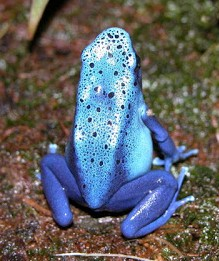
Ventral: underside
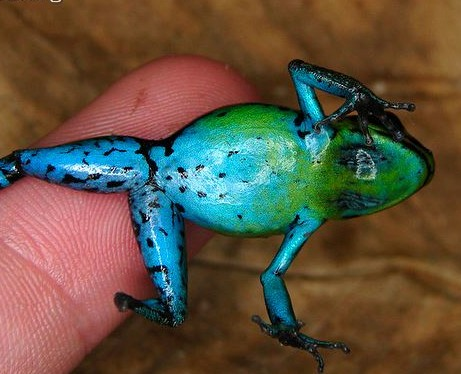
Visual background: Poison dart frogs live on different natural substrates; live dead plant parts, so this would bring about different visual backgrounds.
Visual systems: In this study they are referring to how predators "view" D. pumilo. Remember, not all predators will see their prey the same way.
Color polymorphisms: alternative phenotypes, and in this case alternative phenotypes of frog skin color.
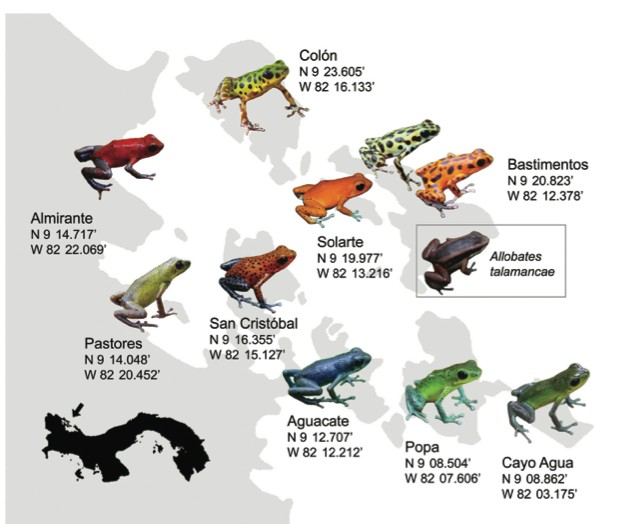
Figure 1. Sampled populations of Dendrobates pumilio in the Bocas del Toro Archipelago, Panama. From Isla Bastimentos, two D. pumilio color morphs were collected (green and orange), as well as four individuals of the closely related but nontoxic control species Allobates talamancae.
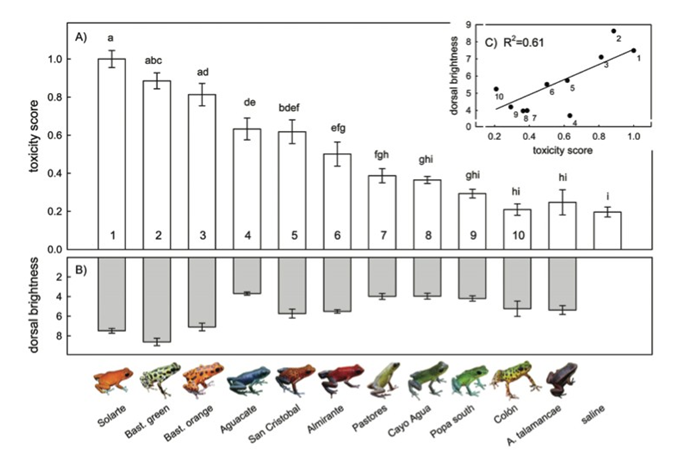
Figure 2. Toxicity scores and coloration brightness in Dendrobates pumilio. A, Open bars indicate toxicity scores with standard errors. Different letters above the bars indicate statistically significant differences; numbers are population numbers referred to in C and in subsequent figures. Allobates talamancae (a closely related Dendrobatid frog) and saline solution served as toxicity measure controls. B, Gray bars indicate the overall brightness of dorsal coloration (total reflectance flux, SR, in arbitrary units) for the 11 frog taxa. C, The inset gives the correlation between toxicity and dorsal brightness for the 10 D. pumilio populations. Numbers refer to the population labels in A.
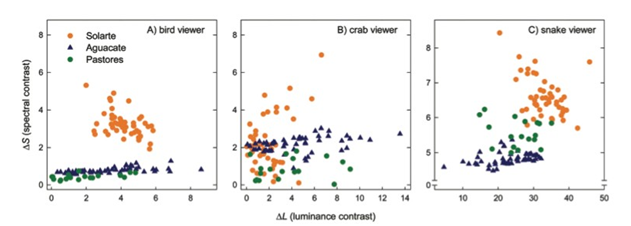
Figure 3. Illustration of the perceptual differences between potential predator taxa in species-specific color space. Plots show the estimated brightness and color contrast generated by the dorsal coloration of individuals from three Dendrobates pumilio populations (Solarte [orange], Aguacate [blue], and Pastores [green]), viewed against a Heliconia background, in the visual systems of birds, crabs, and diurnal snakes. Each dot represents reflectance spectra measured from an individual frog. The relative conspicuousness of the different frog morphs differs by viewer. For example, while crabs tend to perceive greater color contrast (DS) for blue frogs compared to green frogs, the difference is reversed for the snake visual system and negligible in the bird visual system.
Questions:
1. What type of control was used in this study? Why do you think they used this control?
2. Intrepret Figures 2 and 3. What were the results from each figure.
3. Is visual conspicuousness and toxicity is correlated? Give examples from Figures 1-3 to support your answer.
4. Were there differences between visual backgrounds and predator visual systems on detection of D. pumilo? Give examples from the figures to support your answer.